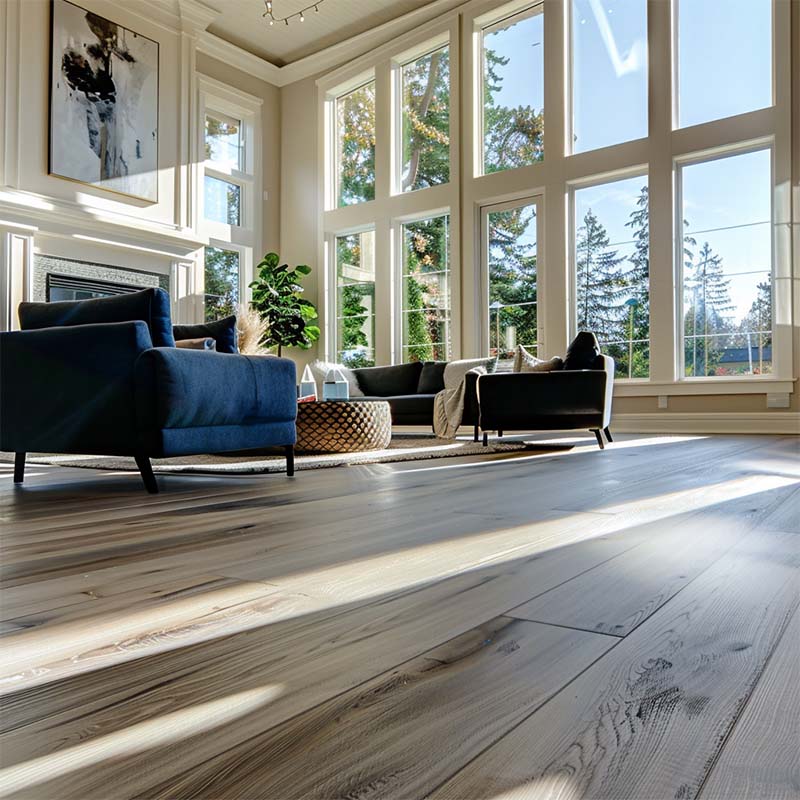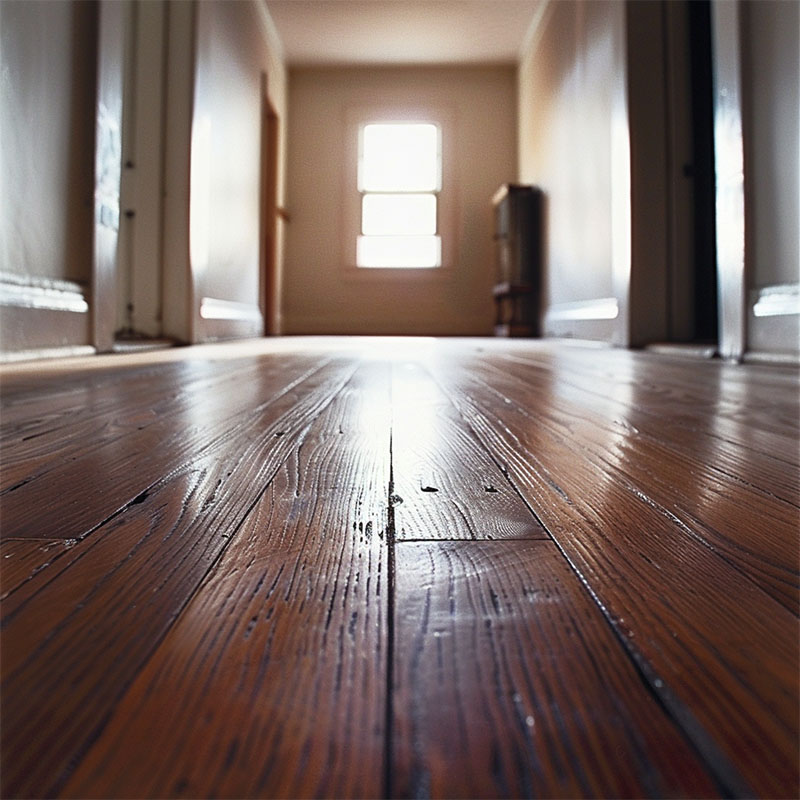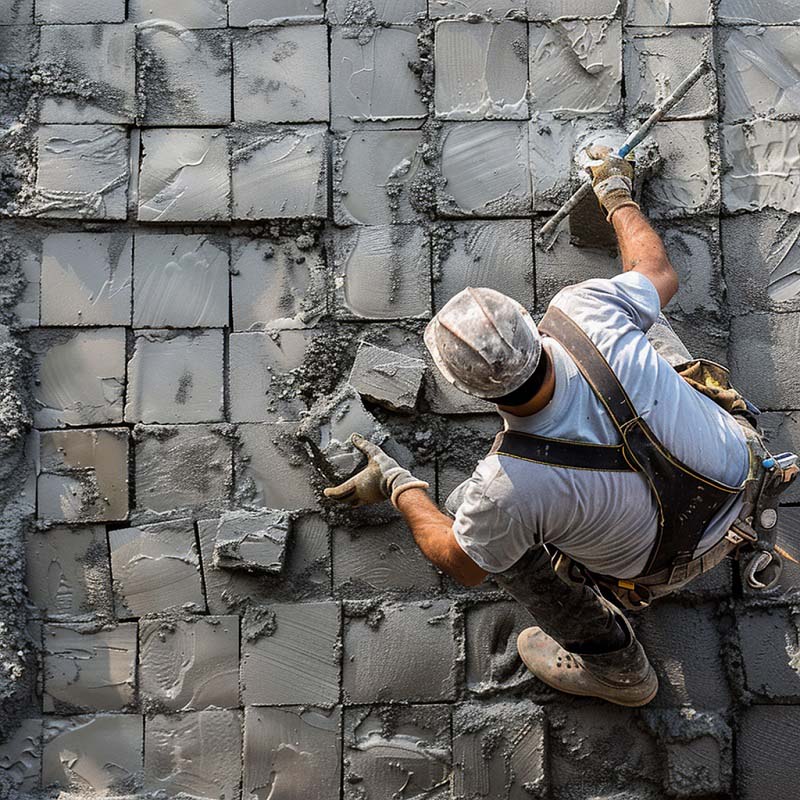SPC rigid core flooring is taking interior design by storm. It offers a unique blend of performance and affordability in a variety of applications. But, every home is different. Find out if SPC is right for yours in our complete guide.
What is SPC Rigid Core Flooring?
Stone plastic composite (or SPC) rigid core flooring is considered an upgrade to luxury vinyl floors even though they contain very little vinyl. Instead, it features a strong core made from stone powder, stabilizers, and polyvinyl chloride. The result: exceptional durability built right into the core of each plank. Oh, and it’s completely waterproof.
Additional SPC Layers
The rigid core isn’t the only component making up SPC planks. They actually feature an engineered design, meaning each plank or tile is composed of multiple layers. Here’s a quick look at each one.
Underlayment (Backing) Layer
An underlayment (or backing) layer is attached to the bottom of the rigid core. It’s typically made out of EVA or IXPE foam. This enhances support for the core and makes the floor a little more comfortable to walk on.
Luxury Vinyl Print (Photographic) Layer
This layer gives the its aesthetics. It’s a high-resolution vinyl photograph that depicts the wood or stone design chosen for that particular floor. This is what allows SPC rigid core floors to mimic natural hardwood planks or stone tile.
Wear Layer
The wear layer protects the photographic layer. It’s a thick, invisible layer that enhances the overall durability. It’s also sometimes used to match the textures depicted in the print layer, giving a more authentic overall style. Thicker wear layers do a better job of protecting against scuffs and scratches.
The resistance of wear layers can be measured by its thickness. Obviously, thicker wear layers offer more protection against scuffs and scratches. The most common are:
- 12mil: the thinnest, but still durable enough for nearly any home. It’s even approved for light commercial applications.
- 20mil: most SPC wear layers used in businesses come in 20mil.
- 22mil: this layer is designed for heavy commercial use.
- 30mil: this thickness is designed for heavy, abusive traffic.
How Did SPC Rigid Core Flooring Come About?
SPC rigid core flooring is essentially an upgraded version of another innovation: luxury vinyl floors. Luxury vinyl plank (LVP) and luxury vinyl tile (LVT) were both upgraded version of vinyl floors. Vinyl floors gained popularity quickly when they first entered the market due to their price, styles, and waterproof design. However, they tore easily and were known to turn a shade of yellow over time.
Luxury vinyl planks solved both of those problems. They featured an engineered layered design (similar to engineered hardwood planks) that improved durability. Some newer luxury vinyl floors now offer enough durability to rival their natural hardwood and stone counterparts. And, they’re still completely waterproof even when fully submerged. They’re also more affordable than their natural counterparts.
Now, SPC floors are taking these benefits to the next level. They replace the vinyl component with the stone polymer core discussed earlier. They’re still completely waterproof, offer more durability, and often cost less than LVP and LVT flooring.
SPC Flooring Thickness
Unlike luxury vinyl floors, the thickness of rigid core flooring isn’t necessarily tied to its durability. SPC floors are specifically designed to offer more durability in a plank that’s thinner and lighter.
Still, SPC rigid core planks are often defined by their thickness. Some of the most common thicknesses include:
- 5mm
- 5.5mm
- 6mm
- 6.5mm
Remember, the thickness is more relevant to the goals for your space than the actual durability of each plank. This is especially important if you plan to install floating SPC floors over your existing flooring.
Still, thicker planks may offer very subtle increases in durability.
Benefits of SPC Rigid Core Flooring
SPC floors truly are a state-of-the-art innovation. Here’s a quick look at what sets them apart.
Durability
We previously noted that the durability of luxury vinyl floors often rival their natural counterparts. Rigid core floors truly live up to their name – they’re even more durable than luxury vinyl. We’re talking about a floor that’s specifically designed to last a lifetime under kids, pets, and heavy foot traffic.
Scratch Resistance
The wear layer of SPC rigid core planks and tiles features a rugged build that offers unparalleled protection. This means that pets and kids will have a tough time scuffing or scraping the surface of your floor.
Quiet
The underpaid foam layer naturally reduces sound. This means you can walk more quietly through your home without disturbing others. It also means less sound transfer between different levels in your home.
Affordability
Luxury vinyl floors were known for their affordability. SPC floors tend to cost even less – and we’re not just talking about the initial sale price.
SPC floors are built to last a lifetime. Their exceptional durability, stability, and scratch resistance means that you may realistically never have to replace your flooring again! So, SPC rigid core floors cost less both short-term and long-term.
Style
A floor that performs well at a better price must skimp on style, right? Actually, no.
SPC floors offer exceptional, high-resolution vinyl aesthetics that perfectly mimic the visuals of hardwood and tile flooring. They also have thick wear layers that are sometimes designed to perfectly mimic the textures depicted in the photographic layers.
Even better, the versatility of photographic layers allow manufacturers to create unique designs that just aren’t possible with their natural counterparts. This may include adding unique color tones or even new, creative designs.
That’s why SPC rigid core floors are available in tons of different colors and designs. They truly offer enough style options for anyone!
Planks Vs. Tile
You’ve probably seen several references to “planks” and tiles” here. This is a reference to the style of a stone-plastic composite floor. Basically, SPC floors designed to resemble hardwood floors are called planks. Floors designed to resemble stone are called tile.




